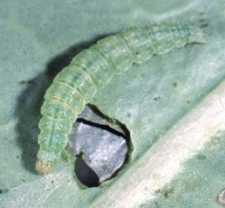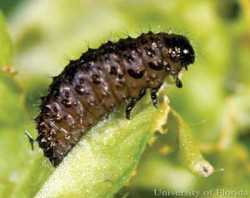The Diamondback Moth And Yellow Margined Leaf Beetle Are Two Foes You Should Know
Cruciferous vegetables are a large and important crop group to Florida agriculture. A number of insects feed exclusively on crucifers and can affect an assortment of highly valued crops such as broccoli, cabbage, cauliflower, collards, mustard, turnip, watercress, and Chinese cabbage. Two insects that impact crucifers include the diamondback moth Plutella xylostella (L.), perhaps the most serious pest of crucifers, and the yellow margined leaf beetle (Microtheca ochroloma Stål). This article will examine the biology of these two foes and the damage they inflict.
Diamondback Moth
The female moth of this species will deposit her eggs on the underside of the leaf surface as either a single egg or in groups. Eggs of the diamondback moth are yellow or pale green, oval and flattened in appearance and are very small measuring 0.44 mm in length and 0.26 in width.
Within two or three days the eggs will hatch out to begin their feeding habits. The diamondback has four instars with the larvae remaining very small and abundant throughout each one. Depending on weather conditions, it can take on the average 25 to 30 days from egg to pupal stage with perhaps eight to twelve generations per year in South Florida.
The pupa stage will appear as a loose transparent case attached to the lower or outer part of the leaves, in cauliflower and broccoli, pupation may occur in the florets. The pupa is yellowish 7mm to 9 mm in length with the cocoon lasting from 5 to 15 days. In its first instar the larvae are colorless but subsequently turn green as they mature. Their bodies have a tendency to taper at both ends with a set of prolegs that form a distinctive V protruding from the posterior end of the larvae. The adult diamondback will appear as a small grayish brown moth with elongated antennae. The slender moth is about 6mm long, and distinguished with a broad cream or light brown band along its back. When identifying the adult look for constrictions on the cream band, it’s these constrictions which give it its common name diamondback.
Plant damage is caused by the small abundant larvae that will consume plant leaves but not the veins. In this stage damage will appear especially on seedlings and have the potential to disrupt head formation in cabbage, broccoli, and cauliflower.
In South Florida, increase of diamondback moth activity will occur between the months of December and March, attacking the crops anytime during the cycle. During this period fields should be scouted walking in a Z or figure 8 patterns. Either way, it is important to scout quadrants, inside and around the perimeter of the field. As part of your scouting tool box try to stock a 10X lens, note pads and pencils for reporting, and clear plastic bags with tweezers for collecting.
Yellow Margined Leaf Beetle (YMLB)
This beetle also is an important insect pest on all members of crucifers crops. YMLB was first reported in Alabama in 1947. Today this leaf beetle is active along the gulf coast from Florida to Texas, and in Georgia and North Carolina. For the conventional grower, YMLB can be controlled by foliar insecticides, however; for organic growers who cannot use similar control tactics YMLB is a major concern.
The eggs of the YMLB are bright orange, elongated and are deposited as either a single egg or in small groups. When searching for the eggs look on both the stems of the plants and under fallen debris collecting on the soil surface.
The larva will have a grayish to yellow appearance with a sclerotized head capsule. As they mature and become ready to pupate, they construct a fine layer of brownish net-like hair which will surround their cocoons. The pupa cases of the YMLB can be easily found attached to the undersides of leafs and visibly contrast the green foliage they are attached to.
The YMLB adult is about 5mm long with the females typically larger than the males. YMLB receive their name from the yellow margins found on the brownish to black elytra of the insect. Elytra are modified, hardened forewings and serve as protection for the hind wings. If conditions are favorable YMLB can complete their life cycle in less than a month. After a period of six days from pupae emergence adults begin to mate, with the females capable of laying eggs within three to six days.
Hosts for YMLB are all in the plant family Cruciferae. Vegetable crops that are damaged by this pest include broccoli, cabbage, cauliflower, collards, mustard, radish, turnip, and watercress as well as mizuna, and napa cabbage.
In Florida, YMLB is present in the field during the cool months between October and April, with most of the damage occurring in spring when both the larval and adult stages will feed on host crops. Both stages will feed on the foliage and the leaf margins leaving small holes on the leaves. Together the adults and larvae are capable of defoliating a host plant in a short period of time. When scouting for YMLB use the same approach as the diamond – back moth.
Both the diamondback moth and the yellow margined leaf beetle are advisories of cruciferous vegetables. When attempting to control these two beetles it is important to understand their life cycles, appearance and damage. It’s this understanding coupled with good scouting procedures that can help achieve better control saving the grower from damaged crops and loss of income.
Selected References:
Capinera, J. L. Diamondback Moth, Plutella xylostella (Linnaeus) (Insecta: Lepidoptera: Plutellidae)1 Published January 2000. Revised September 2011. Reviewed September 2012 EENY-119 (IN276), Department, Florida Cooperative Extension Service, Institute of Food and Agricultural Sciences, University of Florida.











